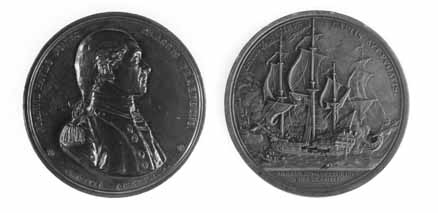Comitia Americana medal, Jones off Scotland's coast
To order an image, navigate to the full
display and click "request this image"
on the blue toolbar.
-
Choose an alternate description of this item written for these projects:
- Object of the Month
- Object of History, 2013 Exhibit
- Main description
Congress authorized a series of medals, the Comitia Americana medals, to commemorate significant American victories during the revolutionary war. In 1787 Congress passed a unanimous resolution to present John Paul Jones with one of these medals.This medal was the first naval medal authorized by Congress, and the only medal within the Comitia Americana series dedicated to a naval victory. As with the military medals included in the series, the John Paul Jones medal was designed and struck at the Paris Mint.
The obverse features a right profile portrait of Jones after Jean-Antoine Houdon's bust, with a legend that translates to "The American Congress to John Paul Jones, Commander of the Fleet." The reverse depicts the U.S. frigate Bonhomme Richard on fire, with her crew boarding the damaged British frigate Serapis in the foreground.The reverse legend translates to "The enemy's ships captured or put to flight at Scotland's shore 23 Sept. 1779." Copper restrikes have been available from the Paris Mint since the 1790s. In 1863 the United States Mint created dies from a restrike, leaving off the engraver's name.
About the Victory of the Bonhomme Richard
This medal celebrates the astonishing victory of the Bonhomme Richard, commanded by John Paul Jones,
over HMS Serapis on September 23, 1779, during the American Revolution. Commodore John Paul Jones,
commanding a combined French and American squadron, had spent the months leading up to the battle raiding the
British coast and disrupting trade, but he was always looking for an opportunity to engage the enemy. On the
23rd of September, off of Flamborough Head on the northeast coast of England, he found what he was looking for,
a large convoy of merchant vessels from the Baltic escorted by HMS Serapis. The engagement began at nightfall
and the Bonhomme Richard was badly damaged early in the closely fought battle (mostly by the explosion of its own
defective cannon—note the damage to the hull of Jones's ship depicted on the medal). When his ship's colors were
shot away and his opponents hailed him to ask if he had surrendered, Jones famously is supposed to have exclaimed:
"I have not yet begun to fight"—although at least one contemporary account suggests that he replied:
"I may sink, but I'll be damned if I strike." In any case, with that the Bonhomme Richard continued to engage the
Serapis at close range, the ships essentially locked together. After more than three hours, the much more powerful
Serapis surrendered, even though the battered Bonhomme Richard would sink soon after the battle. During a grim
period of the Revolution, Jones had won an inspirational victory.
About John Paul Jones
John Paul Jones, a self proclaimed "Citizen of the World", was born on July 6, 1747, on the southwest coast of Scotland. Interested in the sea from an early age, he eventually would serve on everything from merchant ships to slave vessels. He was involved in a number of controversies (and once accused of murder) and fled to the British North American colonies in 1773. At the beginning of the American Revolution he was able to secure a lieutenancy in the fledgling Continental Navy, and merit soon brought him to the rank of captain and commodore. While he later admitted the American navy did little to advance the goal of independence, Jones's inspiring victories did much to boost the moral of both the Americans and their French allies. After the war Jones spent most of his remaining life in France, enjoying the company of his former allies. He also fought for the Russians as a rear admiral in their war against Turkey. He died in France in 1792, unappreciated by his American contemporaries. More than a century later he was re-interred at the United States Naval Academy in Annapolis, Maryland, recognized as a hero to his country and father of the United States Navy.Sources for Further Reading:
Betts, Charles Wyllys. American colonial history illustrated by contemporary medals. Boston: Quarterman Publications: Boston, 1972 reprint of 1894 edition.
Julian, R.W. Medals of the United States Mint, the first century, 1792-1892. El Cajon: Token and Medal Society, 1977.
Morison, Samuel Eliot. John Paul Jones A Sailor's Biography Boston: Little Brown, 1959.
Thomas, Evan. John Paul Jones: Sailor, Hero, Father of the American Navy. New York: Simon & Schuster, 2003.

